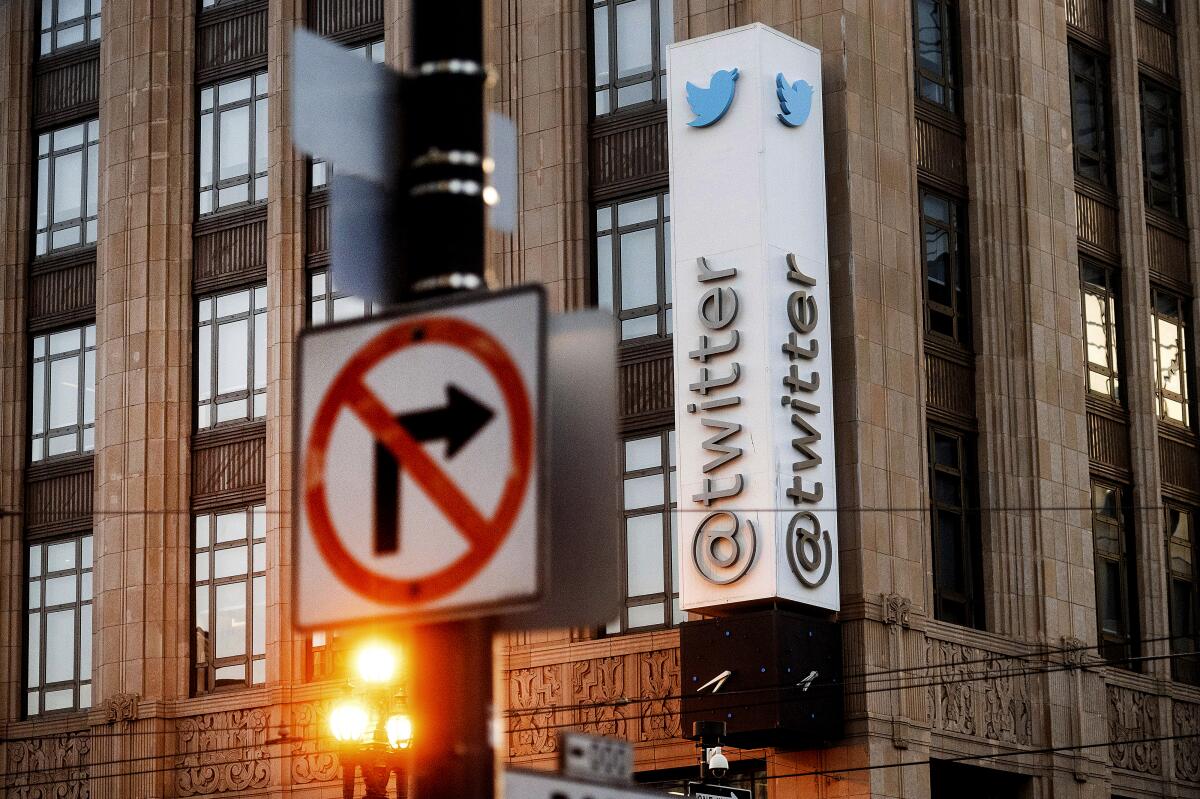9th Circuit says Twitter can’t disclose FBI ‘national security’ demands for user info

- Share via
Twitter may not publicly quantify the number of times the FBI demands user information from it for national security investigations, a federal appellate court ruled Monday.
The three-judge panel of the U.S. 9th Circuit Court of Appeals ruled that the FBI was justified in blocking the social media giant from publishing aggregate counts of such requests in its biannual “Transparency Report” online because doing so could jeopardize national security.
Circuit Judge Daniel Bress, an appointee of President Trump, wrote that although the court acknowledged “Twitter’s desire to speak on matters of public concern,” the “government’s restriction on Twitter’s speech is narrowly tailored in support of a compelling government interest: our Nation’s security.”
The decision affirms a similar ruling by a lower district court judge in 2020. Bress was joined in his decision by two other conservative judges: Carlos Bea, who was appointed by President George W. Bush, and Lawrence VanDyke, a Trump appointee who also wrote a concurring opinion.
Attorneys for Twitter and for the federal government did not respond to requests for comment.
Some observers criticized the decision as a blow to the 1st Amendment rights of people and entities such as Twitter that find themselves caught up in national security cases or want to publish information about them.
“This ruling is really undermining those 1st Amendment protections for anyone who gets swept up in a super-secret government investigation,” said Andrew Crocker, senior staff attorney for the Electronic Frontier Foundation, which had filed a brief in support of Twitter.
Twitter first filed its lawsuit challenging the FBI’s directive not to publish the figures during the Obama administration in October 2014.
Legal wrangling over disclosures of how often the government requests information from social media companies and just what kind of information agencies wanted erupted at the start of that year. That’s when big companies such as Google and Facebook said they wanted to disclose more about government surveillance on their platforms in the wake of Edward Snowden’s revelations about the vast scope of U.S. surveillance efforts.
In response, the U.S. government agreed to allow companies to release information about the number of information requests they had received, but with limits. The government said the companies could report only the number of requests in “bands” of 1,000. That is, companies could report receiving between zero and 999 such orders but could not provide more detail or specify the exact number of requests they’d received. They also could not disclose that they had received no such requests in any given period.
In April 2014, Twitter provided the FBI with a draft of its latest Transparency Report, in which it quantified the number of requests for user information it had received from the FBI in much smaller increments.
The report was going to quantify “national security letters,” through which the government can request subscriber information and billing records in national security cases. It was also going to quantify orders under the Foreign Intelligence Surveillance Act, or FISA, which allows for court-ordered surveillance in real time or the release of stored content and other records by a company such as Twitter.
Twitter officials wanted to say how many of each sort of request it had received from the government by increments not of 1,000, but of 25 — that is, that it had received between 1 and 25 such requests, or between 25 and 50. They also wanted to be able to say whether the company had received no such requests.
The FBI pushed back, ordering Twitter not to publish the report because it included classified information that would harm national security if released.
Twitter responded by filing suit, arguing that the restrictions were “an unconstitutional prior restraint and content-based restriction on, and government viewpoint discrimination against, Twitter’s right to speak about information of national and global public concern.”
The government disagreed, though the details of its arguments were obscured because they were filed under seal. The reason: Government officials said they included classified information.
In its decision Monday, Bress said the court had reviewed those records and determined that the government had met its burden of proving the restrictions were necessary. It was unclear Monday whether the panel’s decision would be appealed.
Crocker, of the Electronic Frontier Foundation, said he was “very disappointed” in the ruling and hoped it would be challenged.
Action by the government to block publication of material in advance — known as “prior restraint” — is subject to the strictest legal standard of review, given the sanctity of the 1st Amendment, and it has been rejected in incredibly important cases in the past, Crocker said.
Perhaps most famously, the U.S. Supreme Court in 1971 rejected the government’s argument for blocking the publication by newspapers of the Pentagon Papers, a classified study of U.S. decision-making in Vietnam.
Crocker said the 9th Circuit panel had strayed from the standards around prior restraint that have protected free speech for years and set a “very, very bad precedent for 1st Amendment in national security cases.”
In a 2022 report, Twitter said the U.S. accounted for 20% of all government information requests globally during the period under review, which was the most of any single country.
More to Read
Sign up for Essential California
The most important California stories and recommendations in your inbox every morning.
You may occasionally receive promotional content from the Los Angeles Times.











